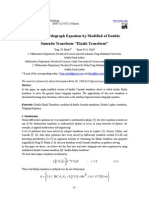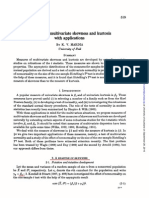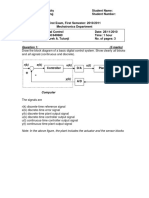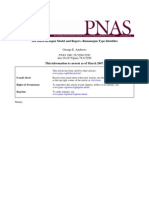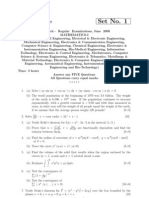Mathematical Association of America
Mathematical Association of America
Uploaded by
anon020202Copyright:
Available Formats
Mathematical Association of America
Mathematical Association of America
Uploaded by
anon020202Original Title
Copyright
Available Formats
Share this document
Did you find this document useful?
Is this content inappropriate?
Copyright:
Available Formats
Mathematical Association of America
Mathematical Association of America
Uploaded by
anon020202Copyright:
Available Formats
A Faster Product for $\pi$ and a New Integral for ln $\frac{\pi}{2}$
Author(s): Jonathan Sondow
Source: The American Mathematical Monthly, Vol. 112, No. 8 (Oct., 2005), pp. 729-734
Published by: Mathematical Association of America
Stable URL: http://www.jstor.org/stable/30037575 .
Accessed: 08/02/2015 19:57
Your use of the JSTOR archive indicates your acceptance of the Terms & Conditions of Use, available at .
http://www.jstor.org/page/info/about/policies/terms.jsp
.
JSTOR is a not-for-profit service that helps scholars, researchers, and students discover, use, and build upon a wide range of
content in a trusted digital archive. We use information technology and tools to increase productivity and facilitate new forms
of scholarship. For more information about JSTOR, please contact support@jstor.org.
Mathematical Association of America is collaborating with JSTOR to digitize, preserve and extend access to
The American Mathematical Monthly.
http://www.jstor.org
This content downloaded from 128.235.251.160 on Sun, 8 Feb 2015 19:57:14 PM
All use subject to JSTOR Terms and Conditions
ACKNOWLEDGMENT. The author thanks the referee for remarksthat improved this note immeasurably
both mathematicallyand linguistically.
REFERENCES
1. N. I. Akhiezer, Theoryof Approximation(trans.C. J. Hyman), FrederickUngar, New York, 1956.
2. S. N. Bernstein,D6monstrationdu thoreme de Weierstrassfondde sur le calcul de probabilit6,Proc. Math.
Soc. Kharkov13 (1912/13) 1-2.
3. M. H. Stone, The generalized Weierstrassapproximationtheorem, Math. Mag. 21 (1948) 167-184, 237-
254.
4. K. Weierstrass,Uber die analytische Darstellbarkeitsogenannterwillkiirlicher Functionen einer reellen
Vertinderlichen,Berliner Berichte (1885) 633-639, 789-805.
Departmentof Mathematics, The Universityof Toledo, Toledo, Ohio 43606
rnagise@math.utoledo.edu
A Faster Product for Trand
a New Integral for In 7
Jonathan Sondow
1. INTRODUCTION. In [17] we derived an infinite product representation of eY,
where y is Euler's constant:
=(2)1/2 22 1/3 (23 4)1/4 24 .44 )1/5
1 (1-3 1-33 1-3-5 (1)
Here the nth factor is the (n + 1)th root of the product
H (k + 1) 1)k+1(
1
k=O
In the process we noticed a strikingly similar product representationof 7:
n 2 /2 22 1/4 23 418 24 . 44 1/16
2 )1/ (i-3)1 (3 )1/ (1-36-5)1/6 (2)
In this note we give three proofs of (2). The third leads to an analog for ln(7r/2) of
integrals for ln(4/7r) [16] and y [15], [16], [17]:
In -= -x dx, (3)
2 J[o,l (1 +x)ln x
4 f 1-x
ln - - - dxdy, (4)
S n (1 + xy) Inxy
[0,1]2
S 1 -x dx dy
[0,1]2
October 2005] NOTES 729
This content downloaded from 128.235.251.160 on Sun, 8 Feb 2015 19:57:14 PM
All use subject to JSTOR Terms and Conditions
Using (3), we sketcha derivationof (1) and(2) fromthe samefunction(a formof the
polylogarithm[10]), accountingfor the resemblancebetweenthe two products.The
functionalso leadsto a productfor e (dueto J. Guillera[6]),
(2)/ 22 123 .41/3 24 44 )1/4
e= () 1-3)
3 1 33 1(3-s)5 " (5)
surprisinglyclose to product(1) for eY. (A generalizationof (5), related to the
Bolthausen-Sznitman coalescentin probabilitytheory,has been found by C. Gold-
schmidtandJ. B. Martin[5].)
2. THE ALTERNATINGZETA FUNCTION. The logarithm of product (1),
namely,
n0 1 f k/I\
y' =1-n-
n= n +1 k=0(- 1 k+lyjln(k
k + 1), (6)
remindedus of the series(see [1, eq. 5.16], [8, p. 464], and[13])
*(s) 2n+ (-1) (k + 1) (s C), (7)
n=0 k=0
whichgives the analyticcontinuationof the alternatingzeta function *(s). The latter
is definedby the Dirichletseries(see [14])
00 (-1)k-1
*(s)= ( ((s > 0). (8)
k=l
(For example,using the classic formula *(1) = In2 for the alternatingharmonic
series-for a new proof see [14]-one can derive the series ln 2 = n>,, (2"n)-1
from (7) by consideringit when s = 1.) Differentiating(7) termwiseand substitut-
ing the value of the derivative of * at s = 0,
1 r
*'(0) = - In - (9)
2 2
(see [13]), yields the series
n
ln _ 2l1(
- 1 k=0 (_l ln\k (10)
andexponentiationproducesproduct(2).
3. WALLIS'S PRODUCT AND EULER'S TRANSFORM. The pair of infinite
products(1) and (2) calls to mind anotherpair,Wallis'sproductfor nr[19] and Pip-
penger'sproductfor e [12]:
rt 2244668
e (2)1/2 (2 4)1/4 4 6 6 8)1/8
2 i1 (33) (5577) -(2
730 THE MATHEMATICAL ASSOCIATION OF AMERICA [Monthly 112
This content downloaded from 128.235.251.160 on Sun, 8 Feb 2015 19:57:14 PM
All use subject to JSTOR Terms and Conditions
It is interesting to note that products (2) and (12), whose factors have exponents 1/2",
converge rapidly to numbers Jr/2 and e/2 whose irrationalityhas been proved (see, for
example, [11]), whereas product (1), with exponents 1/(n + 1), converges less rapidly
to a number eY whose (expected) irrationalityhas not yet been proved.
We give a second proof of (2) using (11) and Euler's transformationof series,
(-1)n-lan 2n+1 (-1)k ak+l, (13)
n=l n=0 k=0 k
valid for any convergent series of complex numbers [9, sec. 33B], [13]. Applying (13)
to the logarithm of Wallis's product
In (-1)n-1 In n (14)
n=1
gives
n 0 1 ) lnk+2
In - = ( Ink+ (15)
n=0 k=0 W /c
If we replace n with n - 1, write the last logarithm as ln(k + 2) - ln(k + 1) and the
sum on k as the difference of two sums in the first of which we replace k with k - 1,
then the recursion
(n - (n- 1 (n\
k -i)+ nki)-]\k
leads to (10), completing the second proof of (2). The first proof is basically the same,
because in [13] we use Wallis's productto evaluate (9), and we take the Euler transform
of (8) to get (7) for complex s with 9t(s) > 0.
Products (12) and (11) are linked by Stirling's asymptotic formula
n! ~ (n/e)/2nn,
which is proved in [3] using (11) and is used in [12] to establish (12). Products (1)
and (2) are linked by transformations:a hypergeometric one [17] for (1) and Euler's
for (2). (To strengthen the link, we can write series (14) and (15) as integrals of hy-
pergeometric functions-compare [17, Proof 1]-and then obtain (15) from (14) by a
hypergeometric transformationequivalent to (13).) However, this link does not explain
the remarkableresemblance between (1) and (2).
Euler's transformationaccelerates the rate of convergence of a slowly converging
series such as (14) (see [9, sec. 35B]). Thus, product (2) converges faster than prod-
uct (11), as Figure 1 (courtesy of P. Sebah) shows.
4. AVOIDING EULER. A third proof of (2) (due in part to S. Zlobin [20]) avoids
using Euler's transformationaltogether (compare the proofs avoiding hypergeometric
functions in [17]). We show that
f00 /f1 0 /1 - \n+1
I :=f j
Jo =
xy
2
dx dy = In -.
2
(16)
This implies (2), because if we factor 1 - x from the integrand and use the binomial
theorem, then termwise integration (justified since the integrand is majorized by the
October 2005] NOTES 731
This content downloaded from 128.235.251.160 on Sun, 8 Feb 2015 19:57:14 PM
All use subject to JSTOR Terms and Conditions
2 2
1.9 1.9
1.8 1.8
1.7 1.7
1.6 1.6
1.5 1.5
1.4 1.4
1.3 1.3
1 2 3 4 5 6 1 2 3 4 5 6
Figure 1. Partialproductsof Wallis's productand its Euler transform.
series 2-"-') yields (15) and, therefore, (2). To prove (16), we use the geometric
series summations
" 1-x n+l 1-x (1-x)2 00
S ^
= - ^(\- = (1 _x)2X2n
n=O 2 1+ x 1-x2 =(1
n=O (17)
to write
I= (1 - x)2xy+2"ndx dy.
The integrandis majorized by C (n + 1)-2 (because
max (1 - x)2x2n ( 1 2 n - 1
o<x< n+1 ( n+1 (n+1)2
and x y 1), so we may perform the integrationsterm by term, which by invoking (11)
gives
00 (2n + 2)2 22 42 62 27
I= ln( =InI - = ln--.
no (2n+1)(2n+3) 133.55.7 2
This proves (16) and completes the third proof of (2).
Proof of (3). Equation (16) and the first equality in (17) yield
f0 ff 1-x
xY- dx dy - In .
o o 1+x 2
Reversing the order of integration (permitted since the integrand is nonnegative), we
integrate with respect to y and arrive at formula (3).
Alternatively, one can derive (3) from (4) by making the change of variables
u = xy, v = 1 - x and integrating with respect to v: the result is In 2 minus inte-
gral (3) (with u in place of x), and equality (3) follows. U
5. RELATING THE PRODUCTS FOR ir AND e". Recall that we derived product
(2) for Jrfrom the alternatingzeta function * (s). Omitting details, we sketch a deriva-
732 THE MATHEMATICAL ASSOCIATION OF AMERICA [Monthly 112
This content downloaded from 128.235.251.160 on Sun, 8 Feb 2015 19:57:14 PM
All use subject to JSTOR Terms and Conditions
tion of product (1) for eY from a generalization of *(s). This accounts for the resem-
blance between the two products. (Formulas (18) and (19) are due to J. Guillera [6].)
We generalize series (7) for *(s) by defining the function
f(t,s)= tn+l (-1)k (k+ )- s (-1 <t < 1, s C), (18)
n=0 k=0 k
so that f(1/2, s) = '*(s). Using integral (16) but replacing (1 - x)/2 with t(1 - x),
we can show that the formula obtained from (3) and (9),
1 r1 1-x
2J (1 + x)lnxdx,
extends to
f'(t, 0) = - 1t2 - dx, (19)
(1 - t (1 - x)) lnxx
where the prime ' is shorthandfor a/as.
We now derive product (1) by evaluating the integral fo t- f'(t, 0) dt in two dif-
ferent ways. On the one hand, a glance at (18) reveals that this integral equals the right
side of (6). On the other hand, substituting (19) into the integral and reversing the order
of integration gives
f'(t,) f1 f1 t(l-x) 1 1 1
Sf(t-O)dt = - dtdx= +- dx.
Jo t (1 - t (1 - x)) Inx J Inx 1- x
The last is a classical integral for Euler's constant [2, sec. 10.3], [17], and (6) follows,
implying (1).
Otherproducts can be derived in the same way. For example, exponentiating the in-
tegral f1 t-2 f'(t, 0) dt = 1 gives product (5) for e, which converges more slowly than
Pippenger's product for e, because of the exponents 1/n in (5), versus 1/2" in (12).
In order to identify the function f(t, s), we reverse the order of summation in (18)
and sum the resulting series on n. We then replace k with k - 1, obtaining
f (t, s) - k + 1) - kl ks (20)
for t satisfying -1 < t < 1/2 and for suitable s. Therefore, f(t, s) and '*(s) are
related to the function
tk
F(t, s) = - (- 1 t < 1,( () > 0)
k=l
by the formulas
f (t, s) = -F(t/(t - 1), s), (21)
*(s) = -F(-1, s),
for appropriatet and s. (With t = 1/2, equations (18) and (20) verify that formulas (7)
and (8) for *(s) agree.) The function F(t, s), a special case of the Lerch transcendent
October 2005] NOTES 733
This content downloaded from 128.235.251.160 on Sun, 8 Feb 2015 19:57:14 PM
All use subject to JSTOR Terms and Conditions
P(z,s, v) (see [4, sec. 1.11], [18, Sec. 64]), is the polylogarithmLis(t) when s is an
integer [10, p. 189], [18, secs. 25, 64]. Relations(18) and (21) lead to an analytic
continuation of F(t, s), and thus of the polylogarithm [7].
REFERENCES
1. P. Biane, J. Pitman, and M. Yor,Probabilitylaws related to the Jacobi theta and Riemann zeta functions,
and Brownianexcursions, Bull. Amer.Math. Soc. 38 (2001) 435-465.
2. G. Boros and V. Moll, Irresistible Integrals: Symbolics,Analysis, and Experimentsin the Evaluation of
Integrals, CambridgeUniversity Press, Cambridge,2004.
3. A. J. Coleman, A simple proof of Stirling's formula, this MONTHLY 58 (1951) 334-336.
4. A. Erd6lyi, et al., Higher TranscendentalFunctions, The Bateman ManuscriptProject, vol. 1, McGraw-
Hill, New York, 1953.
5. C. Goldschmidtand J. B. Martin,Randomrecursivetrees and the Bolthausen-Sznitmancoalescent, Elec-
tron. J. Probab. (to appear);also available at http://arxiv.org/abs/math/0502263.
6. J. Guillera,personal communication,25 July 2003.
7. J. Guilleraand J. Sondow, Double integralsand infinite productsfor some classical constantsvia analytic
continuationsof Lerch's transcendent(2005, preprint);available at http://arxiv.org/abs/math/0506319.
8. H. Hasse, Ein Summierungsverfahrenfuirdie Riemannsche (-Reihe, Math. Z. 32 (1930) 458-464.
9. K. Knopp, Theoryand Application of InfiniteSeries, Dover, New York, 1990.
10. L. Lewin, Polylogarithmsand Associated Functions, Elsevier North-Holland,New York, 1981.
11. A. E. Parks, rt,e, and other irrationalnumbers,this MONTHLY 93 (1986) 722-723.
12. N. Pippenger,An infinite productfor e, this MONTHLY 87 (1980) 391.
13. J. Sondow, Analytic continuationof Riemann's zeta function and values at negative integers via Euler's
transformationof series, Proc. Amer Math. Soc. 120 (1994) 421-424.
14. - , Zeros of the alternatingzeta function on the line 9(s) = 1, this MONTHLY 110 (2003) 435-437.
15. - , Criteriafor irrationalityof Euler's constant,Proc. Amer Math. Soc. 131 (2003) 3335-3344.
16. - , Double integralsfor Euler's constant and ln(4/r) and an analog of Hadjicostas's formula, this
MONTHLY112 (2005) 61-65.
17. - , An infinite productfor ev via hypergeometricformulasfor Euler's constant, y (2003, preprint);
available at http://arXiv.org/abs/math/0306008.
18. J. Spanierand K. B. Oldham,An Atlas of Functions, Hemisphere,New York, 1987.
19. J. Wallis, Computationof n by successive interpolations,in A Source Book in Mathematics,1200-1800,
D. J. Struik, ed., Princeton University Press, Princeton, 1986, pp. 244-253; reprintedin Pi: A Source
Book, 2nd ed., L. Berggren, J. Borwein, and P. Borwein, eds., Springer-Verlag,New York, 2000, pp.
68-77.
20. S. Zlobin, personal communication,26 May 2003.
209 West97th Street,New York,NY 10025
jsondow @alumni.princeton.edu
Generalizationsof Fermat's Little Theorem
via Group Theory
I. M. Isaacs and M. R. Pournaki
1. INTRODUCTION. As is well known,Fermat'sso-called little theoremasserts
that if p is prime, then aP = a (mod p) for all integers a. This is usually proved by
consideringtwo cases:theresultis trivialif a = 0 (modp), andit followsfromthe fact
thataP-'1 1 (modp) if a is notdivisibleby p. Thislatterfactis generallyestablished
by an appealto the theoremof elementarygrouptheorythatassertsthataIGI= 1 for
everyelementa of a finitegroupG.
734 THE MATHEMATICALASSOCIATIONOF AMERICA [Monthly 112
This content downloaded from 128.235.251.160 on Sun, 8 Feb 2015 19:57:14 PM
All use subject to JSTOR Terms and Conditions
You might also like
- Isye 6669 Midterm I: Instructor: Prof. Shabbir Ahmed and Prof. Andy SunDocument10 pagesIsye 6669 Midterm I: Instructor: Prof. Shabbir Ahmed and Prof. Andy SunhaoNo ratings yet
- Larry Williams (Seminar Notes)Document6 pagesLarry Williams (Seminar Notes)fredtag4393100% (2)
- N. David Mermin - Space and Time in Special Relativity-McGraw-Hill, Inc. (1968) PDFDocument264 pagesN. David Mermin - Space and Time in Special Relativity-McGraw-Hill, Inc. (1968) PDFanon020202100% (2)
- Pathophysiology of Brain TumorsDocument15 pagesPathophysiology of Brain TumorsTRASH MAILNo ratings yet
- Zionism, Crypto-Judaism, and The Biblical Hoax, by Laurent Guyénot - The Unz ReviewDocument19 pagesZionism, Crypto-Judaism, and The Biblical Hoax, by Laurent Guyénot - The Unz Reviewanon020202100% (1)
- Spookmaster Pumpkin Carving Patterns Book 2Document62 pagesSpookmaster Pumpkin Carving Patterns Book 2Mister MisterNo ratings yet
- Another Proof of 6ζ (2) =π^2 Using Double Integrals - Daniele Ritelli (AMM, v120, n7, 2013)Document5 pagesAnother Proof of 6ζ (2) =π^2 Using Double Integrals - Daniele Ritelli (AMM, v120, n7, 2013)Leandro AzNo ratings yet
- On The Series Å K 1 (3kk) - 1k-nxkDocument11 pagesOn The Series Å K 1 (3kk) - 1k-nxkapi-26401608No ratings yet
- Euler Sum NimDocument18 pagesEuler Sum NimasidoNo ratings yet
- Denef H10AlgIntegerRingsII PDFDocument11 pagesDenef H10AlgIntegerRingsII PDFJan DenefNo ratings yet
- Inverse Elliptic Functions and Legendre PolynomialsDocument5 pagesInverse Elliptic Functions and Legendre Polynomialsعقبة عقبةNo ratings yet
- Assignment - 2 - Crystallography II - SolutionsDocument6 pagesAssignment - 2 - Crystallography II - Solutionsep21b004No ratings yet
- Quantitative Bounds For The Recursive Sequence Y: Kenneth S. Berenhaut, John D. Foley, Stevo Stevi CDocument7 pagesQuantitative Bounds For The Recursive Sequence Y: Kenneth S. Berenhaut, John D. Foley, Stevo Stevi CAyaMagdyNo ratings yet
- Generalized JacobsthalpolynomialsDocument6 pagesGeneralized JacobsthalpolynomialsVAHID VAHIDNo ratings yet
- Abaqus Simulating Thermal Expansion PDFDocument6 pagesAbaqus Simulating Thermal Expansion PDFSirilak KlakwongNo ratings yet
- Steck NoteEquicorrelatedMultivariate 1962Document4 pagesSteck NoteEquicorrelatedMultivariate 1962m saNo ratings yet
- New Algorithm To Compute The Discrete Cosine TransformDocument3 pagesNew Algorithm To Compute The Discrete Cosine TransformGalo Roberto Aguirre CoboNo ratings yet
- J Ijleo 2018 09 045Document9 pagesJ Ijleo 2018 09 045ShewlyAktar MistyNo ratings yet
- Asymptotic estimate for Laguerre polynomialDocument13 pagesAsymptotic estimate for Laguerre polynomialtushar3850uNo ratings yet
- NMSE 2016 Exercises 4 SolutionDocument3 pagesNMSE 2016 Exercises 4 SolutionshivaNo ratings yet
- The Mathematical AssociationDocument4 pagesThe Mathematical AssociationHemanth TallaNo ratings yet
- Maximum-Likelihood Estimation of Regressions Containing Unobservable Independent Variables - Goldberger (1972)Document16 pagesMaximum-Likelihood Estimation of Regressions Containing Unobservable Independent Variables - Goldberger (1972)Eduardo Aguirre DávilaNo ratings yet
- (95-103) Solution of Telegraph Equation by Modified of Double Sumudu Transform Elzaki TransformDocument10 pages(95-103) Solution of Telegraph Equation by Modified of Double Sumudu Transform Elzaki TransformAlexander DeckerNo ratings yet
- Grey Markov TheoryDocument5 pagesGrey Markov TheoryAjeng Alfia Fadilla TeguhputriNo ratings yet
- Part 2 - WaveDocument4 pagesPart 2 - WaveRofa HaninaNo ratings yet
- Alzer 3Document5 pagesAlzer 3Universität BielefeldNo ratings yet
- 4 HandoutDocument2 pages4 Handoutaladar520No ratings yet
- Manual EconometricsDocument20 pagesManual EconometricsmrrnahidNo ratings yet
- Mardia (1970)Document12 pagesMardia (1970)brenyokaNo ratings yet
- Dirk Huylebrouck: The American Mathematical Monthly, Vol. 108, No. 3. (Mar., 2001), Pp. 222-231Document11 pagesDirk Huylebrouck: The American Mathematical Monthly, Vol. 108, No. 3. (Mar., 2001), Pp. 222-231SilviuNo ratings yet
- Approximate Formulas For Some Functions of Prime NumbersDocument31 pagesApproximate Formulas For Some Functions of Prime NumbersyanivscribdNo ratings yet
- A Determinant Involving Generalized Binomial CoefficientsDocument112 pagesA Determinant Involving Generalized Binomial Coefficientsksr131No ratings yet
- Eisenstein Final 2010Document42 pagesEisenstein Final 2010TamilselviNo ratings yet
- Control Exam 1 SolutionDocument5 pagesControl Exam 1 SolutiongetugaaNo ratings yet
- On Certain Schlomilch-Type SeriesDocument13 pagesOn Certain Schlomilch-Type Seriesdavid_bhattNo ratings yet
- Dickey, Fuller - 1981 - Likelihood Ratio Statistics For Autoregressive Time Series With A Unit RootDocument17 pagesDickey, Fuller - 1981 - Likelihood Ratio Statistics For Autoregressive Time Series With A Unit RootMengcheng LiuNo ratings yet
- Ematica (Version 4.0) For Linux Show, Among Other Things, That Only 50Document31 pagesEmatica (Version 4.0) For Linux Show, Among Other Things, That Only 50mouton2344No ratings yet
- Feinerman 1976Document4 pagesFeinerman 1976bird75No ratings yet
- An - Article - To - Be - Published - in - The - Future - Optics of The Turbulent AtmosphereDocument11 pagesAn - Article - To - Be - Published - in - The - Future - Optics of The Turbulent AtmosphereElad DakarNo ratings yet
- The Hard-Hexagon Model and Rogers - Ramanujan Type IdentitiesDocument4 pagesThe Hard-Hexagon Model and Rogers - Ramanujan Type Identitiesapi-26401608No ratings yet
- Assignment II-2018 (MCSC-202)Document2 pagesAssignment II-2018 (MCSC-202)ramesh pokhrelNo ratings yet
- K, R R R R JK Exp) R, R (G: (3) Finite-Difference Time-Domain (FDTD) MethodDocument8 pagesK, R R R R JK Exp) R, R (G: (3) Finite-Difference Time-Domain (FDTD) MethodJosNo ratings yet
- Yjcta 4364Document20 pagesYjcta 4364Dan DanielNo ratings yet
- Lupas 1977 Inequalities For The Roots of A Class of PolynomialsDocument8 pagesLupas 1977 Inequalities For The Roots of A Class of Polynomialslitter_trashNo ratings yet
- Wallis Ratio SumDocument10 pagesWallis Ratio Sumnagasakiheroshima33No ratings yet
- Vanden Berghe G, de Meyer H - A Special Identity Between Three 2F1 (A, B C 4) Hyper Geometric Series - J. Comput. and Appl. Math. 160 (2003) 315-321Document7 pagesVanden Berghe G, de Meyer H - A Special Identity Between Three 2F1 (A, B C 4) Hyper Geometric Series - J. Comput. and Appl. Math. 160 (2003) 315-321Renee BravoNo ratings yet
- Solving The Euler Equations On Graphics ProcessingDocument9 pagesSolving The Euler Equations On Graphics Processingeri sugiatmokoNo ratings yet
- SoluciónDocument3 pagesSoluciónMefisNo ratings yet
- Convergent Expansions and Bounds For The Incomplete Elliptic Integral of The Second Kind Near The Logarithmic SingularityDocument26 pagesConvergent Expansions and Bounds For The Incomplete Elliptic Integral of The Second Kind Near The Logarithmic SingularityDimonoNo ratings yet
- The Generalized Integro-Exponential FunctionDocument17 pagesThe Generalized Integro-Exponential FunctionPOPNo ratings yet
- 2236609Document9 pages2236609Simone MontoyaNo ratings yet
- Pi Hua1991Document5 pagesPi Hua1991madanifateh1984No ratings yet
- 2008 2009 1 (Q+S)Document18 pages2008 2009 1 (Q+S)marwanNo ratings yet
- Audio Forensics From Acoustic Reverberation: Hafiz Malik Hany FaridDocument4 pagesAudio Forensics From Acoustic Reverberation: Hafiz Malik Hany FaridTanja MiloševićNo ratings yet
- kedlaya1994Document4 pageskedlaya1994김정훈No ratings yet
- Sachdev P.L., Vaganan B.M., Sivagami G. - Symmetries and Large Time Asymptotics of Compressible Euler Flows With Damping (2008)Document24 pagesSachdev P.L., Vaganan B.M., Sivagami G. - Symmetries and Large Time Asymptotics of Compressible Euler Flows With Damping (2008)Anonymous idBsC1No ratings yet
- 007 - Buku Basic Econometric Damodar N Gujarati 4th Solution-15-25Document12 pages007 - Buku Basic Econometric Damodar N Gujarati 4th Solution-15-25Kurniawan ArikaNo ratings yet
- Measure of Modified Rotatability For Second Order Response Surface Designs Using Pairwise Balanced DesignsDocument11 pagesMeasure of Modified Rotatability For Second Order Response Surface Designs Using Pairwise Balanced DesignsIJRASETPublicationsNo ratings yet
- Class Test 2018-19: Electronics EngineeringDocument9 pagesClass Test 2018-19: Electronics EngineeringAbhishek AgrawalNo ratings yet
- Assignment 3 SolutionsDocument12 pagesAssignment 3 SolutionsshreyaNo ratings yet
- Mathematical Association of AmericaDocument9 pagesMathematical Association of AmericathonguyenNo ratings yet
- Cherednik-1995-Double Affine Hecke Algebras and Macdonald's ConjecturesDocument26 pagesCherednik-1995-Double Affine Hecke Algebras and Macdonald's ConjectureslucassecoNo ratings yet
- Mathematics 1 (June 2009 Regular)Document8 pagesMathematics 1 (June 2009 Regular)micmechNo ratings yet
- Brent and McMillan - 2021 - Some New Algorithms For High-Precision ComputationDocument9 pagesBrent and McMillan - 2021 - Some New Algorithms For High-Precision ComputationsizukhuranaNo ratings yet
- Ramanujan Type 1:pi Approx FormulasDocument17 pagesRamanujan Type 1:pi Approx FormulasuwinakickNo ratings yet
- Harold M. Edwards (Auth.) - Divisor Theory-Birkhäuser Boston (1990) PDFDocument180 pagesHarold M. Edwards (Auth.) - Divisor Theory-Birkhäuser Boston (1990) PDFanon020202100% (1)
- April 19, 1966: K. W. de Baun 3,246,457Document5 pagesApril 19, 1966: K. W. de Baun 3,246,457anon020202No ratings yet
- The Battle For WikipediaDocument8 pagesThe Battle For Wikipediaanon020202No ratings yet
- Studies and Research ProjectsDocument73 pagesStudies and Research Projectsanon020202No ratings yet
- Marsden J.E. - Lectures On Mechanics (1992) PDFDocument233 pagesMarsden J.E. - Lectures On Mechanics (1992) PDFanon020202No ratings yet
- Problems: Don't Look at The Solutions Too Soon!Document17 pagesProblems: Don't Look at The Solutions Too Soon!anon020202No ratings yet
- Large Networks and Graph LimitsDocument487 pagesLarge Networks and Graph Limitsanon020202100% (2)
- The Lost Boarding Pass, and Other Practical ProblemsDocument8 pagesThe Lost Boarding Pass, and Other Practical Problemsanon020202No ratings yet
- Lambert's ProblemDocument18 pagesLambert's Problemanon020202No ratings yet
- CubingDocument7 pagesCubinganon020202No ratings yet
- Evolution of Solar SystemDocument583 pagesEvolution of Solar Systemanon020202100% (1)
- Josephus ProblemDocument7 pagesJosephus Problemanon020202No ratings yet
- Zeta 3 PDFDocument6 pagesZeta 3 PDFanon020202No ratings yet
- Student Understanding of Electric and Magnetic Fields in MaterialsDocument8 pagesStudent Understanding of Electric and Magnetic Fields in Materialsanon020202No ratings yet
- THEMES-Metaphysical PoetryDocument3 pagesTHEMES-Metaphysical PoetryLaura GabrielaNo ratings yet
- Final Tugas 3 Reading IDocument3 pagesFinal Tugas 3 Reading IevanriyansyahforlearnNo ratings yet
- How To Paraphrase EffectivelyDocument15 pagesHow To Paraphrase EffectivelyDoris Shang67% (3)
- Lecture Topic 2.1.6Document10 pagesLecture Topic 2.1.6AvishiNo ratings yet
- Layleen Polanco NYC Board of Correction ReportDocument17 pagesLayleen Polanco NYC Board of Correction ReportNational Content DeskNo ratings yet
- Introduction To Finance: Chapters 9 - 11Document15 pagesIntroduction To Finance: Chapters 9 - 11Xinxin KuangNo ratings yet
- 1st Summative Test in Eng Q4Document3 pages1st Summative Test in Eng Q4Teacher Rovelyn DelgadoNo ratings yet
- Sankata Nasana Ganapati Stotram Lyrics - A Prayer To Remove Obstacles in LifeDocument2 pagesSankata Nasana Ganapati Stotram Lyrics - A Prayer To Remove Obstacles in LifeSuriya NarayananNo ratings yet
- Habte HabtishDocument83 pagesHabte HabtishAsfawosen DingamaNo ratings yet
- Star Wars - PotentiumDocument5 pagesStar Wars - PotentiumDenis Colli MenezesNo ratings yet
- Quality Process Improvement Tools and TechniquesDocument21 pagesQuality Process Improvement Tools and TechniquesEmad BadrNo ratings yet
- Chapter 3.2 BDCDocument36 pagesChapter 3.2 BDCNishu Bade ShresthaNo ratings yet
- Bhagavad GitaDocument16 pagesBhagavad Gitasoxet29916No ratings yet
- Brahmotsavam Part1 PDFDocument34 pagesBrahmotsavam Part1 PDFNarayanamurthyNandagopal100% (1)
- 3 - Motion To Withdraw AppealDocument3 pages3 - Motion To Withdraw AppealReddick RoseNo ratings yet
- AiouDocument14 pagesAiouumerNo ratings yet
- Microprocessor Lab Project EC - 316: Made ByDocument19 pagesMicroprocessor Lab Project EC - 316: Made ByJani ServiniNo ratings yet
- IBM DB2 10.5 For Linux, UNIX, and Windows - Globalization GuideDocument829 pagesIBM DB2 10.5 For Linux, UNIX, and Windows - Globalization GuideBupBeChanhNo ratings yet
- Safeguard Vs Tangco, DigestDocument2 pagesSafeguard Vs Tangco, DigestAngie DouglasNo ratings yet
- Handel Saul Atto 1 LibrettoDocument7 pagesHandel Saul Atto 1 LibrettoMariodelonakaNo ratings yet
- Assignment 6-2Document30 pagesAssignment 6-2Beenish JafriNo ratings yet
- Newsletter of The Old BoysDocument48 pagesNewsletter of The Old BoysAmjad IqbalNo ratings yet
- Bronne Lo TaakDocument3 pagesBronne Lo TaakLuhan ErweeNo ratings yet
- Book 1 WorksheetDocument4 pagesBook 1 WorksheetcrazymonkeywheeNo ratings yet
- Assessment2 - Trillanes, Calixto Vii J. - tcp1bDocument3 pagesAssessment2 - Trillanes, Calixto Vii J. - tcp1bwewe.trillanesNo ratings yet
- Responsible Use of Media and Information During The COVID-19 PandemicDocument5 pagesResponsible Use of Media and Information During The COVID-19 PandemicTara Inada LaranjoNo ratings yet






















